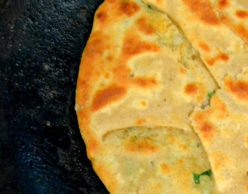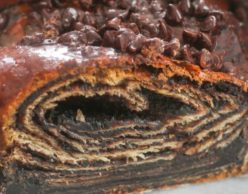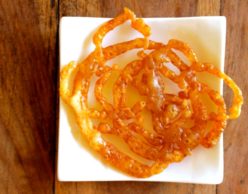Life, Death, And Parathas
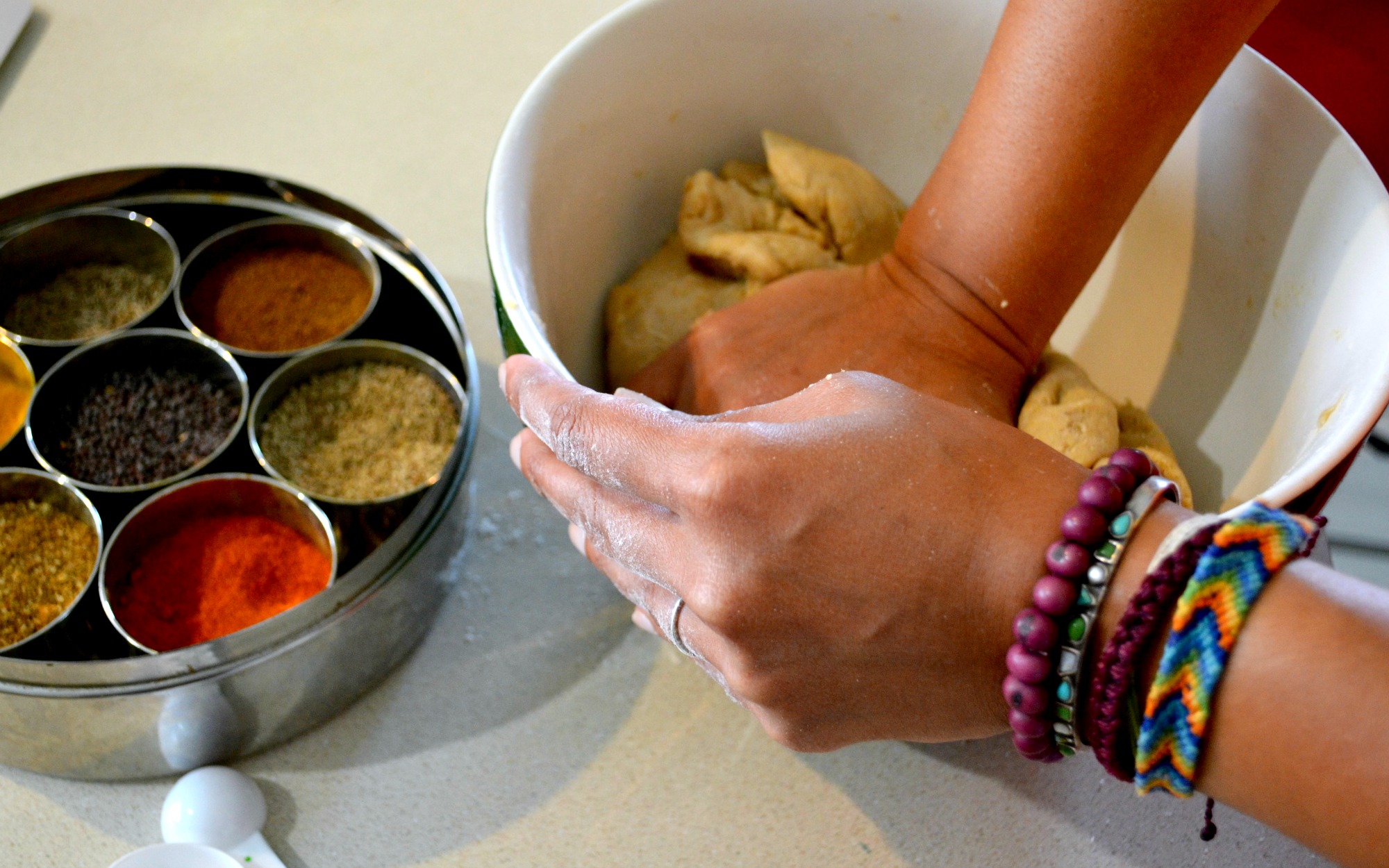
Cultural tradition sweetens our celebrations, imbues our milestones with meaning, and connects our present to a rich and varied past. Ritual also helps us survive life’s hardest moment: death. And what is one of our deepest rituals? Feeding each other, and feeding our souls. In honor of the tenth anniversary of her father’s death, our Indian-American Mash-Up Nishta Mehra finally tackled the task of learning how to make his favorite food: Her mother’s parathas. How does food connect us? In every way.
We’re beyond lucky at Mash-Up HQ to get the recipe for Veena’s parathas. Please note, you can and will find a million versions of these recipes elsewhere, but they won’t be Veena’s.
My mom is famous for her parathas. Within my extended family “village,” Veena’s parathas are prized and treasured, considered a special occasion food, and held up as the gold standard. In college, I would smuggle foil-wrapped stacks of them into my carry-on bags, watching nervously as TSA agents inspected them, threatening to confiscate because they smelled so good. As I grew up, people would often tease me — Make sure to learn her secrets, so you can carry on the tradition! — but even as I became adept at cooking all sorts of Indian foods, I stayed far away from the parathas.
Parathas are griddled, unleavened flatbreads made with very finely ground whole wheat flour and cooked in ghee, butter, or oil. They can be made plain, the dough layered to create a flaky texture, or stuffed with any number of fillings: vegetables, spices, daal, cheese, eggs, meat. Though paratha varieties can be found throughout India, Pakistan, Sri Lanka, Burma, Malaysia, and Indonesia, they are said to originate in the Punjab region of India, where both of my parents are from. Punjab is known as the “bread basket” of India, as it provides the wheat from which parathas and other traditional breads are made.
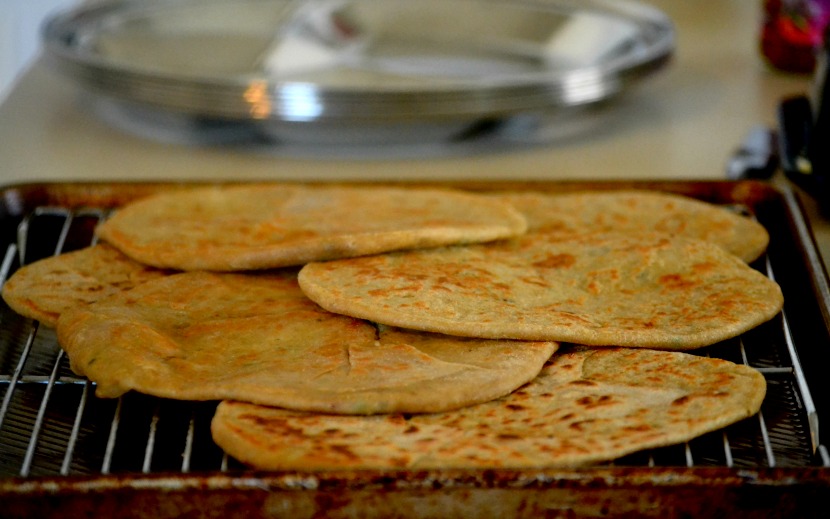
Regional pride and homesickness led my mom to start making parathas after she immigrated to the U.S. in 1968. My dad craved them and there was nowhere to get them in the American South at that time. Though she’s now an enthusiastic consumer of YouTube cooking videos, back then she had to rely on her taste memory and instincts to get the parathas right. Luckily, my father was a willing guinea pig. When I ask her how she got to be such a paratha wizard, she says, “I have no idea…just making them every other damn week, I guess, because your father loved them.”
My father was the exuberant, effusive one in my parents’ relationship. He said “I love you” all the time, snuck up behind my mom while she was standing at the kitchen counter to hug on her or turn her around for a kiss. My mom, on the other hand, was always more reserved, rolling her eyes or pretending to be exasperated with him. For my mom, “there are different ways of showing people you love them — you don’t always have to say ‘I love you.’” She did it with food.
I responded to my father’s sudden death in 2006 by learning how to cook.
It should come as no surprise, then, that I responded to my father’s sudden death in 2006 by learning how to cook the very foods I had grown up watching him eat. I was a graduate student at the time, living far from home, so I spent many hours on the phone with my mom, scribbling down her instructions as I tried to replicate her food. Pre-dating Blue Apron by a decade, she’d send me packages with the spices I’d need, including recipe cards for simple dishes like khichuri and daal. I fantasized about my dad showing up in my kitchen, sneaking just-baked cookies from cooling racks or peeking at bread in the oven.
Cooking became an essential part of my grieving process, as did feeding others the results; over time, I got pretty good, developing my own style and signature dishes, even starting a food blog. I learned to make homemade yogurt, the way I watched my mom do every-other-week when I was a kid. I threw my own Diwali parties, cooking for as many as forty people, and felt that I was earning my place alongside my mom and the aunties whose prodigious hosting abilities had set a high bar. Being a generous and attentive hostess, sending friends out the door with bags full of Tupperware-stuffed leftovers — I knew unequivocally that I was making my parents proud. Even still, I continued to avoid the paratha question. It felt too loaded, too intimidating. What if I couldn’t get it right?
Then, a year ago last April, my best friend’s mom died. Like my father’s death, it was completely unexpected, and as I worked to help my friend navigate a grief I knew all-too-well, I realized; I was taking time with my mom for granted. Though I of all people should know better, I was acting as if I could delay my paratha lesson indefinitely because my mom would always be around.
For almost five years now, my mom’s been literally down the street and completely integrated into my daily life. She moved into a house less than two miles away from mine just a few months after my son, Shiv, was born. Since then, she has helped care for Shiv, cooked us countless meals, and enabled my wife and I to have date nights and travel for work. She is my theatre date and favorite person to take to author readings. She and Shiv adore each other, and she and my wife, Jill, have grown close — something I never could have anticipated. As Jill says, “Our life doesn’t work without Veena.” Except that someday, it will have to.
I realized that my hesitance to learn how to make parathas was directly tied to fear of my mom’s death. Learning to make her signature dish meant acknowledging that someday she, too, will be gone. Losing my dad at a young age has made me both more grateful for the time I have with my mom, and more paranoid that it will end any minute. The thought of losing my mom is devastating, but I cannot control when that will happen. What I can do is enjoy and appreciate her now, and do my best to ensure that I won’t have regrets later.
With that framework, I at last set about learning how to make my mom’s famous parathas: aloo (potato) and gobi (cauliflower). We scheduled “tutorial” sessions, just the two of us in her kitchen, listening to mix CDs I’ve made her over the years. I brought a notebook and a camera, asking her to pause between steps so I could take pictures and eyeball measurements. She was a patient teacher, encouraging me: “Hey, your atta (dough) is even better than mine!” She also warns me: “These things are complicated; in one time, you ain’t going to get it.”
I had no idea how much love and care she was stuffing in as well.
She was right — I definitely never appreciated just how hard my mom’s parathas are to make, how labor-intensive they are. The atta and the fillings have to be made separately, and timed accordingly. Then, the dough is rolled out and stuffed; what makes my mom’s parathas so prized, I learned, is just how much stuffing she manages to fill them with without them breaking. It’s a delicate dance of rolling and folding, some pressure but not too much. I think back to every time my mom ever made parathas — for me and my dad, for me, Jill, and Shiv, for a friend whose husband had just had surgery or a family with a new baby — and realize that I had no idea how much love and care she was stuffing in as well.
I wanted the chance to make parathas by myself, to fly solo and see if I could even come close to replicating the taste and texture I know so well. And because I am a sucker for symbolism and ritual, I decided to cook them on the anniversary of my father’s death, July 22nd, and invite my mom and some friends over for brunch the next day.
My mom, in classic fashion, immediately volunteered to help. Like many givers, she’s not so great at receiving. I didn’t want her to feel cut out of the process, but I wanted to do the lion’s share myself, mostly to see if I could. Mom, not to be outdone, offered to pick up ingredients for me at the Indian grocery store — ”You’re so busy! I’m retired! I’ll do it!” — and answered a few last-minute questions for me as I worked to decipher my notes and remember exactly how she’d done everything.
Though I have much practice ahead of me if I hope to reach my mom’s level of paratha mastery, my first attempt was a success. Rarely has anything made me feel as much like a badass or generated so much complex emotion as cooking and serving those parathas. I spent the actual anniversary of my father’s death mostly alone in my kitchen, alternating between my dad’s old Hindi music and the 70s lite rock my mother favored when I was a kid. Often, on these days, I feel paralyzed, but this time I had something to do, a vehicle for my feelings of loss, gratitude, pride, and nostalgia.
The next day, my friends Dave and Burke arrived with their new baby, Hugo, for his first visit to my house. I’ve known Dave since I was seventeen years old; holding his son in my arms felt like the perfect bridge between what’s been and what was to come. We ate parathas, daal, raita, and homemade mango ice cream; Mom and I took turns rocking the baby, Jill took pictures, Shiv played on the living room floor. My mother is not a sentimental person. She does not do false praise. But I could see her holding back tears. That night, she texted me: “Papa would be so happy and proud.”
I was reminded again what a privilege it is to have your heart both broken and healed by everyday, ordinary life.


